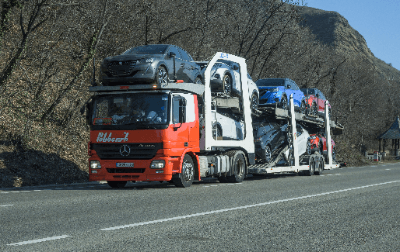What Is a Carrier Car?

A carrier car, also known as a vehicle transporter, is a vehicle designed to transport various vehicles on its cargo bed.
It is also referred to as a vehicle transporter or car carrier. Many people have likely seen trucks carrying vehicles on the road, and most of these are carrier cars. True to its name, a carrier car is a vehicle designed to transport vehicles and must be equipped with facilities to securely fix the loaded vehicles. carrier cars play a vital role in transporting vehicles ranging from motorcycles, regular cars, and compact cars to 2-ton trucks.
Uses of Carrier Cars
Carrier cars are used to transport vehicles from automobile manufacturers’ factories and logistics centers to dealerships or export ports.
Carrier cars with added crane functions are also utilized in scenarios such as the recovery and processing of accident-damaged vehicles. Furthermore, they are useful for transporting vehicles with expired inspections, vehicles in violation of traffic laws, or those rendered inoperable for various reasons.
Principles of Carrier Cars
Carrier cars operate by using the power from the truck’s engine to activate the hydraulic system through a Power Take-Off (PTO). This hydraulic system moves the cargo bed, winch, or crane. During loading and unloading, hydraulic cylinders are activated through lever or remote-control operations to tilt or slide the cargo bed.
Structure of Carrier Cars
The basic structure of a carrier car consists of the vehicle’s body with an engine and driver’s seat, and the cargo bed for loading vehicles. There are several variations in the structure of the cargo bed.
Some carrier cars have inclines for loading, while others tilt the cargo bed by lifting the truck. Additionally, some have a sliding function for the cargo bed, and others are fitted with cranes or winches.
Types of Carrier Cars
There is a wide variety of carrier cars, ranging from those with a sliding mechanism for small trucks transporting a single vehicle to those with a capacity to carry up to eight vehicles when connected. Broadly speaking, there are three types of carrier cars.
1. Loader Type
The loader type is based on a 2-ton truck and can carry one vehicle. This is the most commonly used type and can be driven with a regular driver’s license.
2. Motorcycle Type
The motorcycle type can carry 2 to 5 vehicles, with a two-tiered system for loading on the top and bottom. It is widely used as it can transport multiple vehicles at once, but it requires a large vehicle license to operate.
3. Trailer Type
The trailer type is a large carrier car that is towed. It can carry up to six vehicles, and the trailer is also configured as a two-tiered system. In addition to a large license, a towing license is required to operate. However, as an exception, in Iwate, Miyagi, Shizuoka, Aichi, and Fukuoka prefectures, an application for a structural reform special zone has been made, allowing operation with a total length of 21 meters and a maximum loading capacity of eight vehicles.
How to Choose a Carrier Car
Choosing a carrier car is crucial, and it should be based on the primary use and the location where it will be frequently utilized. This is because the type of carrier car chosen can significantly impact the economic aspects.
Selecting a carrier car that aligns with the primary use and the location of use is essential for efficiency and cost-effectiveness.
Other Information on Carrier Cars
1. Advantages of Carrier Cars
While carrier cars have the advantage of transporting multiple vehicles simultaneously and reducing costs, there are also some disadvantages.
Carrier cars can significantly reduce costs by transporting multiple vehicles at once. Moreover, since they do not increase the mileage of the vehicles to be sold, the value of the transported vehicles does not decrease.
2. Disadvantages of Carrier Cars
Two-tiered carrier cars may encounter potential issues with road height restrictions. It is necessary to confirm the height restrictions on each road along the route to the destination in advance.